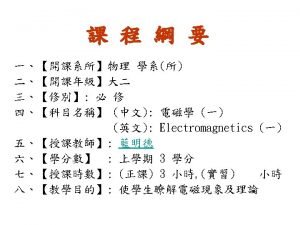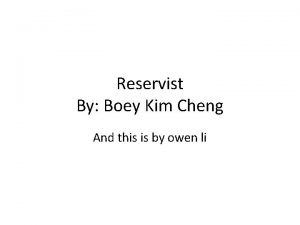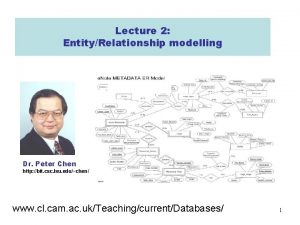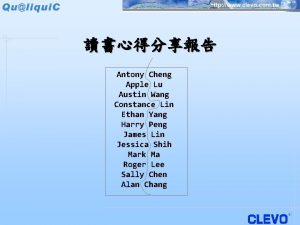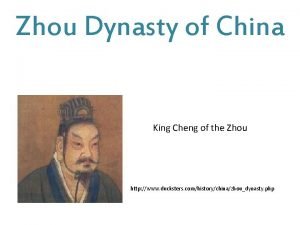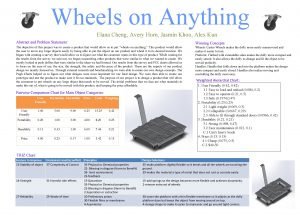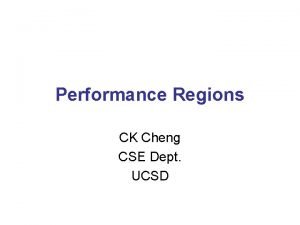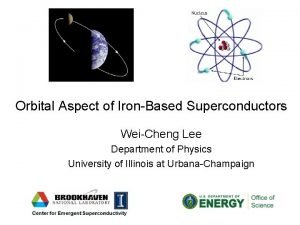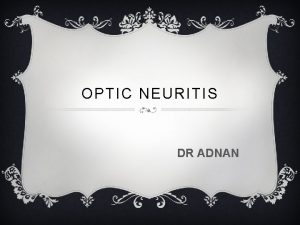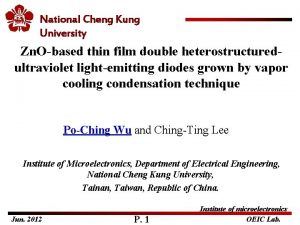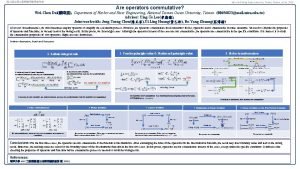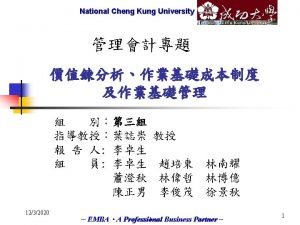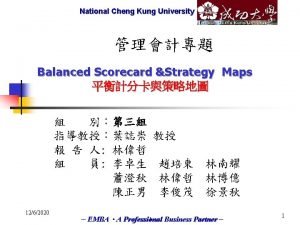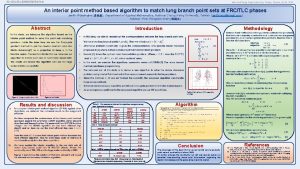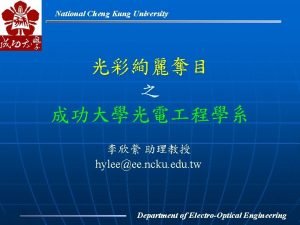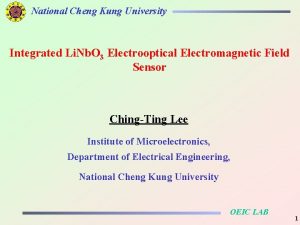2012 OPTIC National Cheng Kung University Generation and
















- Slides: 16

2012 OPTIC National Cheng Kung University Generation and transformation of azimuthal and radial polarization in a typically three-element Nd: Gd. VO 4 laser Ken-Chia Chang, and Ming-Dar Wei* Department of Photonics, National Cheng Kung University, No. 1, University Road, Tainan City 701, Taiwan * mdwei@mail. ncku. edu. tw L 78001070@gmail. com AUG. 19, 2014 Laser Dynamics Lab. P. 0

National Cheng Kung University Outline u u u ü ü ü u u 2012 OPTIC What is the Cylindrical Vector (CV) beam and its applications An overview of Developments of CV beam Previous studies of CV beam under different cavity configurations in our laboratory Intra-cavity axicon (hemispherical cavity) The pulse laser with CV polarization by designing resonator (three-element cavity) Pump profile shaping with axicon and lens (microchip laser) Experiment setup and results Discussion and conclusion Laser Dynamics Lab. P. 1

2012 National Cheng Kung OPTIC University What is the CV beam and its applications Ø Unique Properties : • Strong and localized longitudinal field Electric vector field component • Small spot size by using tightly focused Phys. Rev. Lett. 91, 233901 (2003). Opt. Commun. 179, 1 (2000). Radial polarization Azimuthal Polarization Ø Applications : • High-Resolution Imaging • Plasmon Excitation • Laser Machining • Nanoparticle Manipulation Adv. Opt. Photon. 1, 1 (2009). Laser Dynamics Lab. P. 2

2012 OPTIC National Cheng Kung University Reviews Cylindrical vector beam Passive Superposition Active Specialfabricated devices Inherent Birefringence Form birefringence Brewster axicon Polarization selector Thermalinduced Laser Dynamics Lab. P. 3

2012 National Cheng Kung OPTIC University cavity configuration with intra-cavity axicon Plano-concave azimuthal polarization (Zo) radial polarization (Ze) K. -C. Chang, T. Lin, and M. -D. Wei*, Opt. Express, 21, 16035 (2013). Laser Dynamics Lab. P. 4

2012 National Cheng Kung OPTIC The characteristics of AP ring with pulsed output University in a three-element cavity configuration Condition : z 1 = 20 cm z 2 = 12. 3 cm Cr 4+: YAG K. -C. Chang, D. -L. Li and M. -D. Wei*, JOSA B 31, 382 (2014). Laser Dynamics Lab. P. 5

2012 OPTIC National Cheng Kung University of microchip laser Schematic Z 0 = 83 mm △Z = 5. 91 mm M. -D. Wei*, Y. S. Lai and K. -C. Chang, Opt. Lett. 38, 2443 (2013). Laser Dynamics Lab. P. 6

National Cheng Kung Experiment setup and the analysis of stable region University 2012 OPTIC with a fixed z 1 Laser crystal : 3*3*8 mm 3, 1 at. % -doped, c-cut,AR@800 -1350 nm M 1 :HR@1064 nm ; HT@808 nm L :f = 75 mm,AR@1064 nm M 2(OC) :R = 91% z 1=20 cm 12. 148 ≦ z 2 ≦ 12. 162 cm Prefer generating AP 34. 248 ≦ z 2 ≦ 34. 754 cm Prefer generating RP 12. 148 ≦ z 2 ≦ 12. 162 cm Laser Dynamics Lab. P. 7

National Cheng Kung University The results of pattern formation 2012 OPTIC z 1 = 20 cm Pump power = 4 W Laser Dynamics Lab. P. 8

2012 National Cheng Kung OPTIC Intensity distributions of ring patterns generated from University the cavity when the z 2 was changed (a) z 2=12. 200 cm N AP 12. 175 (c) z 2=12. 360 cm (b) z 2=12. 290 cm N N Un. P 12. 235 RP Un. P 12. 280 12. 300 AP 12. 335 z 2 (cm) 12. 385 Laser Dynamics Lab. P. 9

2012 OPTIC National Cheng Kung Measurement method University slit 300 mm Polarizer Power meter 1. Selecting the measured portion of the pattern 30° 2. Passing through the polarizer 60° 3. Measuring the power by using the power meter 90° Degree of Polarization (DOP) define: (Imax - Imin) / (Imax + Imin) The orientation of the slit is − 30° 4. Determining the polarization direction and degree of polarization by using the fitting curve The red line is the fitting curve with the sin 2 function Laser Dynamics Lab. P. 10

National Cheng Kung University The characteristics of AP and RP ring Case: AP 2012 OPTIC Case: RP Slope = 1. 019 ± 0. 005 Slope = 0. 999 ± 0. 006 Average DOP = 96. 30% ± 0. 87% Average DOP = 92. 20% ± 1. 99% Laser Dynamics Lab. P. 11

2012 OPTIC National Cheng Kung University The quality of CV polarization The position of z 2 (cm) Mode Degree of type Polarization (DOP) Slope efficiency Lasing threshold 12. 200 AP 96. 30% ± 0. 87% 39. 0% 1. 61 W 12. 290 RP 92. 20% ± 1. 99% 38. 6% 1. 45 W 12. 360 AP 93. 70% ± 1. 46% 36. 7% 1. 31 W Why the polarization transformation can be observed? Laser Dynamics Lab. P. 12

2012 National Cheng Kung OPTIC University extraction efficiency for both rays Considering AP 12. 175 Un. P 12. 235 RP Un. P 12. 280 12. 30 AP 12. 335 z 2 (cm) 12. 385 Laser Dynamics Lab. P. 13

National Cheng Kung University 2012 OPTIC Conclusion q We have generated the cavity-length-dependent variation of polarization states from the unstable to stable region in a diode-pumped Nd: Gd. VO 4 laser with a three-element cavity. q By considering the extraction efficiency from pump energy and the variation of spot size in the gain medium for o-ray and e-ray, mechanism of polarization transformation is discussed. Laser Dynamics Lab. P. 14

National Cheng Kung University 2012 OPTIC THANKS FOR YOUR ATTENTION!! Laser Dynamics Lab. P. 15
 Kung fu panda chi
Kung fu panda chi Nalika maca teks pranatacara sikap sing becik yaiku
Nalika maca teks pranatacara sikap sing becik yaiku Mata bugtong
Mata bugtong First generation antipsychotics vs second
First generation antipsychotics vs second From generation to generation we worship you
From generation to generation we worship you National patient safety goals 2012
National patient safety goals 2012 David cheng electromagnetics
David cheng electromagnetics Paradise by boey kim cheng analysis
Paradise by boey kim cheng analysis John cheng md
John cheng md Cheng er model
Cheng er model Antony cheng
Antony cheng King cheng
King cheng Nitra wheels
Nitra wheels Planners by boey kim cheng
Planners by boey kim cheng Cheng
Cheng Ck cheng ucsd
Ck cheng ucsd Wei cheng lee
Wei cheng lee






